Clothing Theory: Heinrich Lüber and Architecture
For quite some time now what has struck me about the performances of Heinrich Lüber are his clothes. As he remains nearly motionless, one has time enough to pay attention to these details. The clothes look very much like those robust, monochromic overalls which mechanics and road construction workers wear, i.e., poorly fitted, somewhat too big jackets and pants out of a stiff, almost wrinkle-free material.
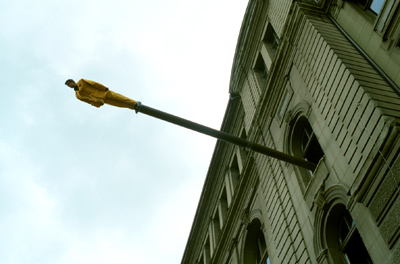
performance in Bern, 2001, Switzerland
photo David Aebi
It is a uniform dress which stylizes the form of the body and makes people look like automatons. They never really seem to identify with their job. In American the term ”blue collar” has come to express this mode, synonym for the worker who executes physical work outdoors or in the factory, contrary to the ”white collar”, the employee who sits in the office in a white shirt.
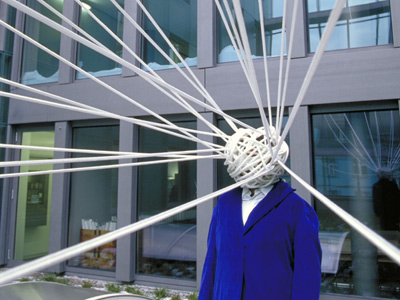
performance at Peter Merian House, 2000, Basel, Switzerland
photo Serge Hasenboehler
Different from the worn, baggy clothes in which many artists imitate ”workers”, Lüber’s clothing is, on the contrary, always impeccably new. The rich hues are adjusted to fit the surroundings: gloomy gray for the Baden train station plaza, dark blue at the Zurich Paradeplatz where the tram tracks cross, stoplight red in the modernistic interior of the National Gallery in Prague. On the one hand, the artist thereby positions himself in the field of painting. The performances, however, take place in space, but at the same time are readable from every viewpoint around as autonomous, composed images.
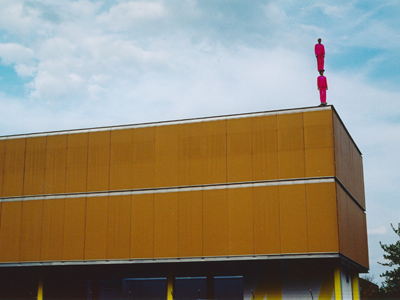
performance in Kloten, 2003, Switzerland
photo Brigit Rufer
Therefore they are always represented in colour, be it as photograph, video or slide. The media traditionally associated with performance, black-and-white photography, which suggests a quick registration in time of one of a progression of moments, is not used by Lüber. On the other hand, the fresh, bright colours of his clothes bring to mind the figure of a doll or puppet.
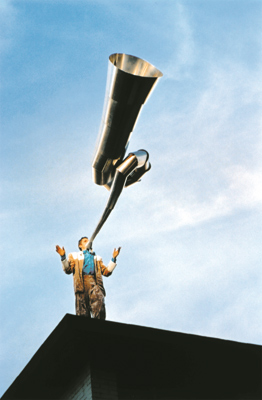
performance in Burgdorf, 2000, Switzerland
photo David Aebi
This impression is intensified in that in most of his performances the limbs of the performer seem to be unnaturally contorted through the use of prostheses. The prostheses serve to fix his body in the most various of positions: hanging at a wall, floating perpendicular over a cone, ascending a steeply-inclining metal construction, etc. A stoic facial expression, which fits well with the machinelike limbs, an always perfect hairstyle and also the language, a seemingly meaningless talking to and repeating himself which Lüber has employed in many performances, all contribute to an overridingly monotonic and mechanical affect.
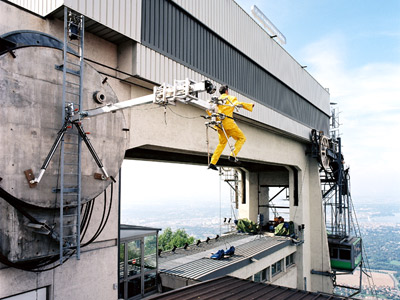
performance in Geneva, 2000, Switzerland photo David Aebi
The joining of the robot-like with the playful results in a peculiar comical quality which is characteristic of Lüber’s performances. During the actual event, as well as in the short video films of the performances which the artist himself commissions, the viewers always seem relaxed, even cheerful. Lüber never confronts the observer frontally nor does he force upon the viewer a determined viewpoint or fixed length of time. At liberty to glance in passing or to watch while hanging around for an hour, there is no action to be followed from beginning to end, no need to be afraid of missing, not ”understanding” or learning something.
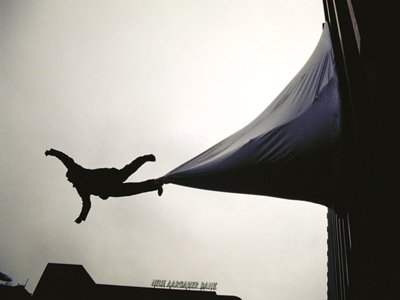
performance in Baden, 2000, Switzerland
photo Serge Hasenboehler
”What is he doing…?” asks a woman off-screen in one of the documentary videos. In fact, above all it is curiosity which can be detected among the audience, not a defensive, even sometimes defiant reaction which many performances within as well as outside of the museum provoke.
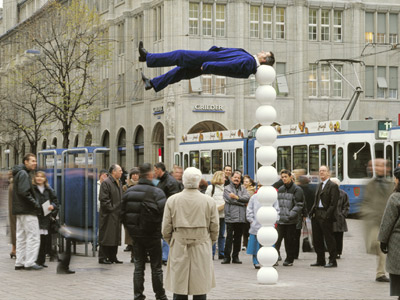
performance in Zurich 1999, Switzerland; Perth and Ballidu, Australia
photo Serge Hasenboehler
The American writer Susan Sontag explains in her essay Happenings: An Art of Radical Juxtaposition (1962) why it seems comical when humans imitate
machines. According to Sontag the mechanical, unnatural movement and repetition have a relaxing effect upon the viewer because they are reversible events. For a moment they allow the human body to seem invulnerable and immortal. They exempt it from tragic, irreversible processes of decay. Lüber operates throughout his work with such reflections. Likewise this is to be found in the development of his Performance Sketches staged only for the camera in which one sees him in the atelier dealing with all kinds of props as if the repertoire of effects resulted in captured moments enacted through performances.
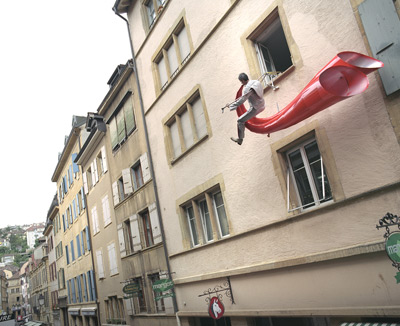
performance in Neuchatel, 2005, Switzerland
photo David Aebi
But it’s not enough to simply compare Lüber performing his own body with the performance of a machine. A central element in his performances is also the fact that as performer he remains nearly motionless over a long period of time, as a rule, for an hour. A deceptive, vaguely decipherable static holds his body in the respective position. For the observer it is obvious that careful preparation and elaborate constructions are necessary in order to achieve the defined form of the performance.
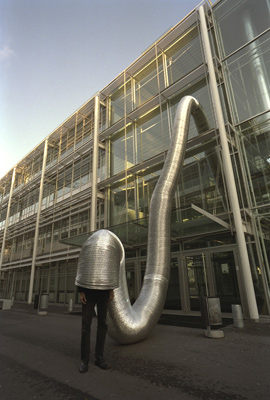
performance in Murten and Bern, 2000, Switzerland
photo David Aebi
With Lüber the performance is not a slowing down or freezing of any kind of ”movement” or “process,” but rather the pragmatic result of planning and construction. This shifts his performances to the vicinity of architecture.
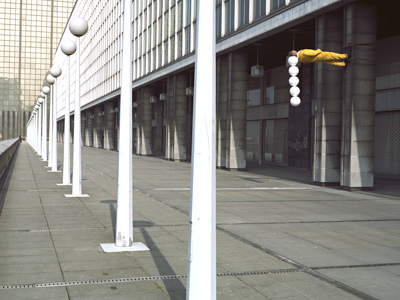
performance for film ”Lüber Aloft” in Bruxelles, 2005/2007, Belgium
photo Mara Truog
As well, many of the performances, like buildings, have no title but rather a single name (e.g., Situation) or an index of location. They can happen in diverse variations at different places. As in the case of architectural photography, their representation is documentational, i.e., categorically subordinate to the actual event.
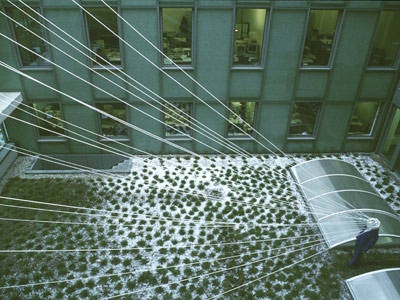
performance at Peter Merian House, 2000, Basel, Switzerland
photo Serge Hasenboehler
In fact, in its initial heyday in the 1960s and early 1970s performance had a striking affinity to architecture. In the 1960s architecture was the scene and theme of happenings and performances, for instance in Red Grooms’ The Burning Building (1959), Allan Kaprow’s Household (1964) or Vito Acconci’s Following Piece (1969). In the 1970s artists like Charles Simonds or Ana Mendieta were interested in a quasi organic merging of body and surroundings, while, in another context, Rebecca Horn, Valie Export or Franz Erhard Walter were concerned with the formal relationship of body and architecture.
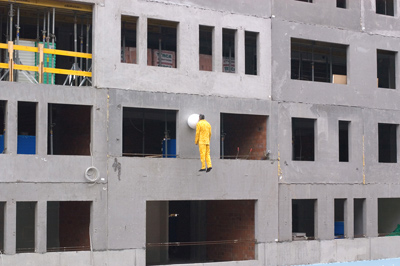
performance for film ”Lüber Aloft”, Bruxelles, 2007, Belgium
photo Mara Truog
Ever since the 1990s when art and architecture once again have been in a vehement relationship with one another, the interest in the history of the influence of performance upon architecture and vice versa has grown.
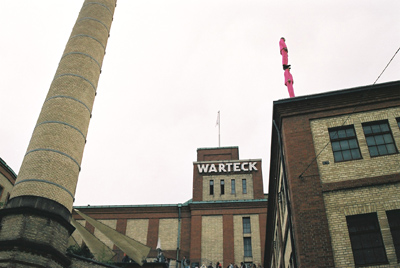
performance at Liste Young Art Fair in Basel, 2006 Switzerland
photo Brigit Rufer
As well, there is a surging interest in theories which might describe, for example, the space in which the human figure and the built environment meet. The performance as an artistic medium, on the one hand, and the theory of the performative, on the other hand, are once again at the centre. Lüber operates in this field. His performances take place within manageable temporal limits. They prevail upon the viewer to observe the body of the artist like a structure – and conversely, the building like another kind of body. For buildings, time passes, so to say, much more slowly than it does for humans. Buildings suggest the comforting notion that they, as a rule, will outlive their builder.
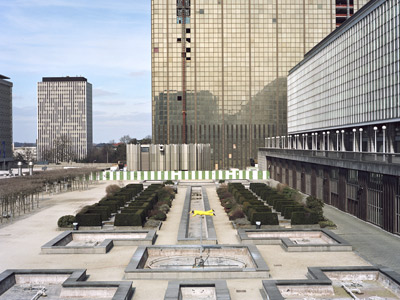
performance for film ”Lüber Aloft”, Bruxelles, 2007, Belgium
photo Mara Truog
(Painfully one always becomes conscious of this whenever buildings are destroyed or too early catastrophically disappear.) Through Lüber’s remarkable establishing of contact with buildings via gigantically enlarged hands, via winding tubes, he appears to confide something to architecture. Seeing him connected with the architectonic grid via trails of fabric, one recalls the patient-naive attempt of scientists to communicate with blue whales or extraterrestrial beings. In Download (1997) when he deliberately talks to the floor and in Show (1999) when his voice cracks and drones over a kind of megaphone-trumpet in order to cheer up the dreary surroundings of the Fine Arts Museum Bern, there is a mixture of fascination and frustration to be detected which every unrequited communication with a mysterious addressee triggers.
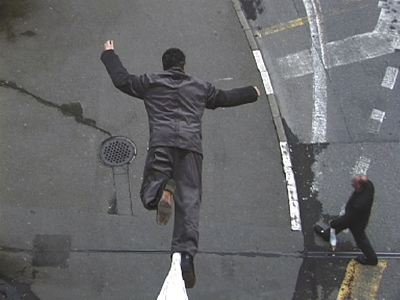
performance in Baden, 2000, Switzerland
photo Serge Hasenboehler
The architect Jacques Herzog told me recently that clothing is an especially speedy kind of architecture. In the shortest time one can dress and undress in order to communicate something about one’s image of the world. In architecture this process takes years. Lüber employs props and protheses to make his body architecture- ”like” in order to find a mutual temporal- spatial language. The clothes which he always carefully chooses, when he gets dressed up in order to communicate with the buildings perhaps make him “understandable” to the built environment. As few other media of the visual arts can articulate the material “time,” in this respect performance is an especially privileged genre. Probably it will never come to a “dialogue,” but precisely out of the impossibility of communicating Lüber develops the tension of his work. There is much to indicate that he will continue to be at the right place at the right time.
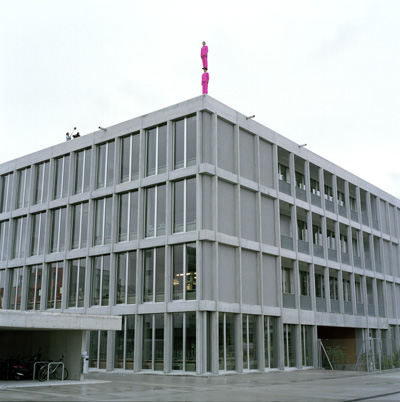
performance in Zurich, 2003, Switzerland
photo Brigrit Rufer
performances by Heinrich Lüber, 1998 - 2007, Basel, Switzerland
text: Dr. Prof. Philp Ursprung, 2001, Swiss Federal Institute of Technology, Zurich, Switzerland
RELATED WEB SITES
→ web-site Heinrich Lüber
→ web-site film(productionhouse)
[ Border Farm Project ]
[ body in context I ]
[ body in context II ]
[ Citizen ]
• Clothing Theory: Heinrich Lüber and Architecture •
[ Family Photo Album ]
[ face to face ]
[ Gefunden — Found ]
[ Giving young Kosovo Albanians a face ]
[ IM PARK_I Lie to History … ]
[ Journey of a Yellow Man ]
[ Letters To Fritz and Paul ]
[ Neo_Celebration ]
[ Pain is Inevitable ]
[ Permanent Breakfast ]
[ Stammer - A Lecture in Theory ]
[ Treibsand ]
[ T’adaad i-sseneen—Counting Years ]
FEATURED THEME ON CITY SHARING
by ASUNCION MOLINOS GORDO
-
This project is an instrument for common critical analysis to help understand the reasons behind Egyptians’ diminishing …
by INAS HALABI
-
The project Letters to Fritz and Paul focuses on the expeditions of the Swiss cousins, lovers and scientists, Fritz and …
by SARAH BURGER
-
The planned modern city of Brasilia attracted me since a long time. Her defined shape, location and function proceded he …
by ADRIEN GUILLET
-
Youri Telliug talks with the artist Adrien Guillet about his project Citracit
Youri Telliug - What is Citracit …
by NIGIST GOYTOM
-
In 2013 more than 45 million people have been forced to leave their homes. This amounts to the biggest number of refugees …
by SULAFA HIJAZI
-
The on going debate on Arab identity and its (cultural) representation is strongly shaped by Edward Saidʼs formative …
by ASUNCION MOLINOS GORDO
-
WAM is a site-specific work that uses the historical trope of the cabinet of curiosities to explore the introduction of …
MORE CONTRIBUTIONS BY THE FOLLOWING